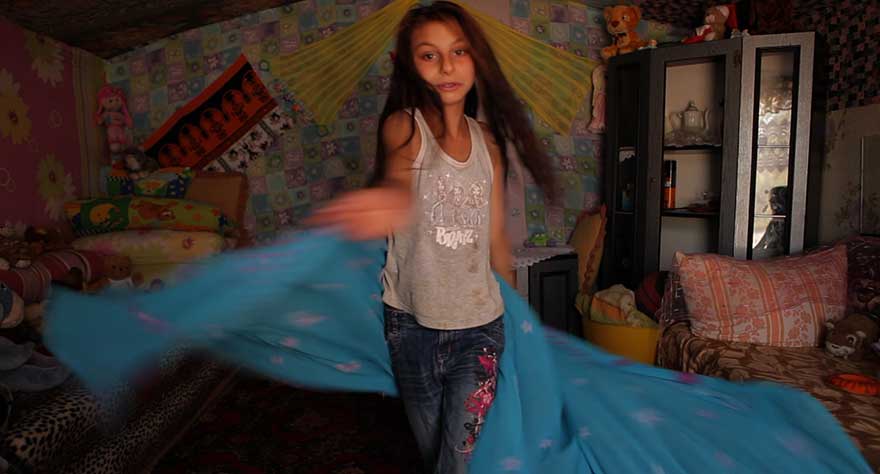
A story about a deaf Roma girl is part heartbreaking documentary, part fanciful musical with results somewhere in between.

A story about a deaf Roma girl is part heartbreaking documentary, part fanciful musical with results somewhere in between.
Director Agnieszka Zwiefka found the untold story of untold stories: among an illegal Roma camp in Wroclaw, Poland, 10-year-old Denisa Gabor is an outcast even among her gypsy family and friends. The young girl fell deaf, by the family’s estimation around age two, and without financial or medical support she simply never learned to speak. She gets by with grunts and hand gestures. The only time she seems to really communicate in the way she wants to is when she discovers a Bollywood tape in a nearby dump and plays it on the old TV in her family’s makeshift home. She mimics the moves, and for once, communication doesn’t seem like a barrier.
Denisa, as one can tell from the title, is the film’s heart and soul, but on the periphery of Zwiefka’s narrative are tensions of social class—both the prejudices of being an outsider and the severe limitations of poverty. The city is in the midst of deciding whether to expel the entire population—one newscast asks, “What should we do with people without education, even papers?”
In the film’s first third, the clash of cultures is really fascinating, if not alarming. The filmmakers don’t explain how Denisa can suddenly afford to get fitted for a hearing aid, but she does, and the doctor’s pointed questions double in showing us the living biases this population faces and the catch-22 of their situation (they can’t get a job without an address; they can’t get health care without a job). Perhaps the most shocking moments, especially in a film starring a 10-year-old girl, is the vulgar language hurled, not just at the adults, from seemingly every direction—elderly on the streets, non-Roma children at the parks, and even from within their own community. As a Western viewer, it’s a bit of an awakening to realize that discrimination against Roma communities is hardly a thing of history and folklore.
Where I get lost a bit is with the film’s Bollywood aspects. Instead of Denisa returning to that initial Bollywood movie or making up her own modest routines like a young kid might, we get several full-scale choreographed numbers: dancing atop rooftops with the kids from her camp, floating through the streets as the whole town comes together like a grand finale of A Chorus Line, and a complex number on a basketball court where she takes center stage like a prima ballerina. My criticism isn’t about the musical aspect itself; the numbers are lovely and colorful (quite literally—she dances in Roma-inspired veils of teal and peach), but I think the Bollywood aspect poses an important question about the film’s narrative. Whether or not you’re fine with their inclusion will be based on how liberal your view of creative nonfiction is, because clearly someone has intervened to choreograph and stage these sequences. Seeing the same girl who seconds ago got shooed away by cops while begging for money come to life is nothing short of inspiring. I’m just wondering if it’s helpful. It’s not making up facts, but it’s making up emotions.
Each of these scenes gets placed very carefully after a particularly difficult real-time conflict: her parents arguing with neighboring families, the police showing up, the nightly news talking about the impending court case regarding the settlement. While the adults look dismal, even angry, the camera shifts to Denisa, going silent except a low buzz—indicating that, perhaps mercifully, Denisa can’t hear any of this. Then, like drifting into a dream, we shift into these imaginative dance sequences, where the world’s problems are a million miles away. As a pure storytelling technique the juxtaposition is lovely. They remind me of a powerful scene in the French film Girlhood where a working class band of friends forget about abusive family members and limited future prospects long enough to belt out to Rihanna’s “Diamonds”—the implication being that despite everything that’s happened to them, their true spirits still live inside them. But Girlhood is fiction, and I’m conflicted on the use of this same technique in a documentary.
As a human being, I can’t help feeling thankful someone gave Denisa a moment to be special, but then, of course, there’s this nagging sense that during these interludes, the film stops being a documentary. They’re an intervention, a fiction, and as such it’s hard to know what is really going on in her mind during these tough times. Having no idea what the film’s core subject is thinking feels like a misstep. At one pivotal moment near the end, we see her hearing aid on the ground, indicating that she chose to stop hearing. The film says choosing not to hear was her choice, but we’re given no exposition in the film itself to know that this was the case. There was no way to know it wasn’t simply from accident—or even neglect. So Denisa remains a mystery, albeit one for whom it’s impossible not to root for.
The dance scenes do break up the melodrama with a bit of hope and energy, though; some of the Roma mystical charm—a moonlit dance in front of a fire—is simply enchanting. But it’s hard to know if the hope the dance elements give is real. Oddly, this leaves me asking more humanitarian questions than most films that tell us what to think provoke. Is ignorance really bliss? How will she live as an adult without speech? Surely, a system that allows a girl to go untreated for a decade is broken? This film focuses its camera only on Denisa and doesn’t pose these bigger questions, but perhaps viewers will take the baton and ask them for her.